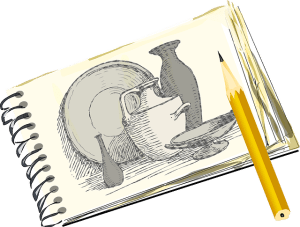 I’ve declared 2015 to be the year I learn to draw adequately. The plan is to make three drawings a week all year, and devise a sort of curriculum for myself. The beginning is a Lynda.com class called 21-Day Drawing Challenge, which is intended to be a daily activity but will fill out January and most of February just fine; I think it’s best if I spend the remaining part of February, and any later last-bits-of-months, attempting to draw items directly relevant to my life. After that I have choices: Foundations of Drawing on Lynda, other online material, or a book from my shelf: Architectural Graphics by Frank Ching (the Amazon link is a much more recent edition, and he’s been elevated to “Francis”), Graphics for Architecture by Kevin Forseth, How to Draw Animals by Jack Hamm, and Creating Characters with Personality by Tom Bancroft. You can see my now-obsolete desire to be better at drawing graphs of equations on chalkboards in those first two, but they should still be applicable to pattern illustration and website sketching.
I’ve declared 2015 to be the year I learn to draw adequately. The plan is to make three drawings a week all year, and devise a sort of curriculum for myself. The beginning is a Lynda.com class called 21-Day Drawing Challenge, which is intended to be a daily activity but will fill out January and most of February just fine; I think it’s best if I spend the remaining part of February, and any later last-bits-of-months, attempting to draw items directly relevant to my life. After that I have choices: Foundations of Drawing on Lynda, other online material, or a book from my shelf: Architectural Graphics by Frank Ching (the Amazon link is a much more recent edition, and he’s been elevated to “Francis”), Graphics for Architecture by Kevin Forseth, How to Draw Animals by Jack Hamm, and Creating Characters with Personality by Tom Bancroft. You can see my now-obsolete desire to be better at drawing graphs of equations on chalkboards in those first two, but they should still be applicable to pattern illustration and website sketching.
Back to that “other online material,” though – I haven’t forgotten that First Friday is supposed to be where I curate the web for you!
The best free drawing instruction I’ve found online is at Learn to Draw.com, by a professional illustrator. He talks about drawing specifically and logically, and gives exercises. Here are a few highlights of the long series: materials, including a useful-looking picture frame, an upside-down drawing exercise, hand tracing for understanding foreshortening, and perspective. Drawing basics leads into a whole series on shading, and then additional series on drawing people and drawing caricatures.
A brief high-level lesson can be found at Diane Kraus’ site, where she covers the steps of drawing (but not how to draw). If you’re interested in drafting, Bob Borson has tips for architectural graphics.
Other specific kinds of drawing: fashion sketching is briefly covered at College Fashion and Fashion Club. For additional unrealistic people, you’ll find a good number of caricature tutorials at Tom Richmond’s blog (an illustrator for MAD magazine). Realistic anatomy for drawing can be taken from Anatomy for Sculptors.
Diane Wright has a quite nice series of nature drawing tutorials; note that most if not all of these have 2 parts, but the link doesn’t stand out so look for it. You’ll find brief but decent still life tutorials at Artyfactory and Art Academy (scroll down; actually, scroll down on both). The first is the traditional fruit and vases, and the second is a shoe.
If you’d like to find more specific tutorials and don’t mind sifting, I have a few last links for you. The John Muir Laws website has a lot of individual tutorials on nature and animal drawing. More animals, realistic or cartoonish, are covered at Drago Art in short and simple tutorials. Finally, there’s a large collection of drawing tutorials from various DeviantArt users you can sort through.
Happy drawing! You won’t see everything I draw this year (that’s a relief, I’m sure), but expect periodic updates with a few favorites and whatever lessons I feel I’ve learned.
Thank you for mentioning my site and tutorial! I wish you all the best on your journey learning to draw. Let me know if there’s any way I can help out!
You’re welcome, and thank you for filling in a gap in the kinds of instruction available. While your piece has such a great combination of high-level approach and specificity that I would have included it regardless, it’s also true that there wasn’t much competition for the “how do I take these trees and make a forest?” kind of lesson. I’ll be returning to it once I get some of the trees under my belt.